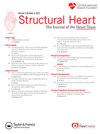主动脉瓣狭窄的急性瓣膜综合征
IF 1.4
Q3 CARDIAC & CARDIOVASCULAR SYSTEMS
引用次数: 0
摘要
研究背景:探讨主动脉瓣置换术对主动脉瓣狭窄(AS)患者临床表现的影响。方法我们分析了来自美国29家医院的真实数据集(egnite数据库,egnite)。18岁以上的中度或以上AS患者接受AVR。根据AVR前临床表现的急性程度和严重程度将患者分为3组:(i)无症状,(ii)进行性体征和症状(进行性瓣膜综合征[PVS])和(iii)急性或晚期体征和症状(急性瓣膜综合征[AVS])。AVR后的死亡率和心力衰竭住院率采用Kaplan-Meier估计,结果采用log-rank检验进行比较。结果在我们的数据库中,2,009,607例患者中,17,838例进行了AVR(78.6%经导管AVR, 21.4%手术AVR)。年龄76.5±9.7岁,女性40.2%。在AVR之前,2504例(14.0%)无症状,6116例(34.3%)出现PVS, 9218例(51.7%)出现AVS。2年时,无症状、PVS和AVS的估计死亡率分别为5.8%(4.6%-7.0%)、7.6%(6.7%-8.4%)和17.5%(16.5%-18.5%),无症状、PVS和AVS的估计心力衰竭住院率分别为11.1%(9.5%-12.6%)、19.0%(17.8%-20.2%)和41.5%(40.2%-42.8%)。调整后,AVS患者AVR后死亡风险增加(风险比,2.2;95% ci, 1.8-2.6)。结论:从一个大型的、真实的AS患者AVR数据库中,大多数患者出现AVS,这与死亡和心力衰竭住院的风险增加有关。本文章由计算机程序翻译,如有差异,请以英文原文为准。

Acute Valve Syndrome in Aortic Stenosis
Background
To describe the impact of clinical presentation among patients with aortic stenosis (AS) undergoing aortic valve replacement (AVR).
Methods
We analyzed a real-world dataset including patients from 29 US hospitals (egnite Database, egnite). Patients over 18 years old with moderate or greater AS undergoing AVR were included. Patients were classified into 3 groups according to the acuity and severity of clinical presentation prior to AVR: (i) asymptomatic, (ii) progressive signs and symptoms (progressive valve syndrome [PVS]), and (iii) acute or advanced signs and symptoms (acute valve syndrome [AVS]). Mortality and heart failure hospitalization after AVR were examined with Kaplan-Meier estimates, with results compared using the log-rank test.
Results
Among 2,009,607 patients in our database, 17,838 underwent AVR (78.6% transcatheter AVR, 21.4% surgical AVR). Age was 76.5 ± 9.7 years, and 40.2% were female. Prior to AVR, 2504 (14.0%) were asymptomatic, 6116 (34.3%) presented with PVS, and 9218 (51.7%) presented with AVS. At 2 years, the estimated rate of mortality for asymptomatic, PVS, and AVS were 5.8% (4.6%-7.0%), 7.6% (6.7%-8.4%), and 17.5% (16.5%-18.5%), respectively, and the estimated rate of hospitalization with heart failure for asymptomatic, PVS, and AVS were 11.1% (9.5%-12.6%), 19.0% (17.8%-20.2%), and 41.5% (40.2%-42.8%), respectively. After adjustment, patients presenting with AVS had increased risk of mortality after AVR (hazard ratio, 2.2; 95% CI, 1.8-2.6).
Conclusions
From a large, real-world database of patients undergoing AVR for AS, most patients presented with AVS, which was associated with an increased risk of mortality and heart failure hospitalization.
求助全文
通过发布文献求助,成功后即可免费获取论文全文。
去求助
来源期刊

Structural Heart
Medicine-Cardiology and Cardiovascular Medicine
CiteScore
1.60
自引率
0.00%
发文量
81
 求助内容:
求助内容: 应助结果提醒方式:
应助结果提醒方式:


